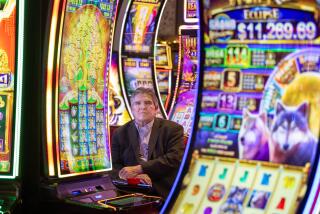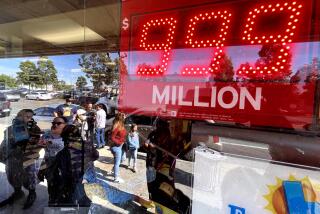In Montana, an old arcade game worth a fortune
She was the queen of the nights out by the river, when lights from the Ferris wheels and the shooting arcades glinted on the water, and the clatter of the old wooden roller coasters mingled with the tinkle of carousels on the warm breeze. It seemed on those nights anything might happen.
In towns across America, a nickel would get pushed into the slot in her glass booth and her gypsy voice would rise. Her black eyes would become suddenly animated, ratcheting to and fro. Her papier-mâché teeth would click menacingly behind her frozen smile.
“You will find marriage three times, each better than the last,” she might say.
Or maybe: “Beware of a dark-haired woman. She is going to get you in trouble.”
These days, most of the trouble is over the gypsy herself — a classic gypsy fortuneteller booth recently discovered, by the outside world at least, in this remote old mining town in the middle of the Montana prairie.
Collectors say the machine is among the most elaborate of the once-popular genre that drew crowds at the elaborate penny arcades and carnivals of the early 20th century. Only one or two of its kind are left in the world.
Illusionist David Copperfield has offered $2 million in goods, services and cash for the mysterious jeweled figure in the glass booth. San Pedro, Calif., collector Theo Holstein said his investors would be willing to go even higher. A well-known Texas auctioneer said he could get $3 million for it.
Yet the offers have been rebuffed — in a place that frankly admits it’s strapped for cash — by directors of the Montana Heritage Commission, which runs most of the town. They say the machine, now sitting in the back of a little-visited tourist arcade, is part of a rapidly disappearing history in a state without a very long past.
“We don’t have any desire whatsoever to sell it. We love her,” commission employee Dianne Carey said last week.
“We’ve been described as a remote and dusty old town — and all of a sudden somebody says this thing [has been discovered that’s] worth all these millions of dollars,” said the commission’s acting director, Marilyn Ross. “Well, we’ve known about her all along.”
Their lack of interest in selling has irked Holstein and other would-be buyers, who find it especially maddening because the fortuneteller’s historical link to the town is itself something of an illusion. Virginia City is celebrated for its mining heyday in the 1860s, but the gypsy, whose true history remains shrouded in mystery, didn’t roll in until nearly 60 years later.
With the historical commission facing a budget crisis that led to the axing of five positions over the last few months, Holstein says, the millions of dollars the gypsy might bring in could help save the historically authentic parts of this dwindling town — now down to 150 people.
As it is, the arcade that houses the fortuneteller is often open no more than two or three days a week, though as many as 1,000 visitors stream in weekly during the short summer season. They come from all over the world, many after visiting Yellowstone National Park.
“You’ve got these crazy curators in there who say, ‘We’d rather sell our soul.’ But the town needs $2 [million] or $3 million more than they need a coin-operated machine,” said Holstein, who phoned the governor’s office not long ago in an attempt to get the state to sell. “They’re like mother hens sitting there: ‘We have something that everybody wants; we’re not going to sell it.’ Well, that ghost town is going to be a ghost town.”
***
Virginia City is unusual among the old mining towns that draw tourists across the West. The town, remarkably, stands pretty much as it was — saloon, mercantile exchange and all — when gold was discovered here in the 1860s.
“Here, you actually had a town that you didn’t need to re-create. It was already here. The buildings were already standing. Very dilapidated, of course, but they were here,” said Kathleen McCourt, cultural resource manager for the commission.
That it wasn’t all torn down for firewood is thanks largely to Charles Bovey, a wheat farmer from Great Falls and heir to the General Mills flour fortune who created and funded a historical society to buy most of the town in 1944.
It was painstakingly restored to what Montana officials say is the West’s best- preserved gold-mining town from the 1860s — for anyone willing to make the 90-mile drive through empty grassland and pine-studded hills from Yellowstone.
The gypsy fortuneteller is one of a large number of arcade games and turn-of-the-century music machines, including some wondrous Giacomo Gavioli fairground organs from Paris, which Bovey collected and ensconced in Virginia City and nearby Nevada City over the course of his long life.
The gypsy was manufactured around 1906 to 1908 by the Mills Novelty Co. The company produced attractions for penny arcades at myriad riverfront amusement parks and the elaborate entertainment palaces, such as those at Coney Island and the 1904 World’s Fair in St. Louis, that drew visitors from all over the world.
Mills’ “Verbal” machine — including the one in Virginia City — was stunning because it spoke a fortune recorded on one of two wax cylinders, one for women’s fortunes and one for men’s, played by a pair of Edison gramophones.
“A really beautiful and remarkably clever machine and the only device of the kind which actually ‘speaks’ the prophesies,” Mills’ catalog boasted. “The amazing life-likeness of her actions holds patrons spellbound, and there is invariably an awe-struck crowd around the machine.”
The company made a nearly identical “Sibille,” which did not speak but handed out fortunes on cards. Three of these are known to exist — one owned by Copperfield, who has an extensive collection of early 20th century arcade machines.
“You look at these machines, and you imagine the hundreds of thousands of people at the turn of the century who needed to dream,” Copperfield said.
“In an arcade you had shooting galleries, so you could see who was the best shot, and a strength test, to see who was the strongest guy in the group — and then they had these fortunetellers. And some people almost kind of believed them. You’d take home the card and say, ‘Wow, maybe this is true.’”
John Ellingsen, who worked for years as Bovey’s curator, said generations of Montanans visited the gypsy after the machine’s arrival in Virginia City. Her voice for a time was kept alive by way of a reel-to-reel tape recorder, until that stopped working in the 1970s. The gypsy, in her lighted, curtained booth, was housed in the Bale of Hay Saloon and later at Bob’s Place pizzeria before moving to her current location in the arcade.
“It was always a spooky-looking thing,” Ellingsen said. “It has the moving eyes, when it works. You put the nickel in and the head kind of turns and looks at you in a very spooky way. It’s just a haunting sort of thing. I think a lot of little kids were scared of it.”
***
For the last several years, the heritage commission has been trying to restore the fortuneteller to, as close as possible, its original condition. All of the moving parts still work. Remarkably, physicist Carl Haber at the Lawrence Berkeley National Laboratory was able to recover the old recordings two years ago with a high-tech optical restoration process that captured audio data without touching and damaging the old wax cylinders.
Curators hope to buy an audio player that would allow the gypsy to once again be operated for visitors, at least on a limited basis. For now, tourists must content themselves with one of several other fortunetelling machines in the Virginia City arcade, all less rare and in better working order.
Last week, commission members entered early discussions with Copperfield about a new offer he’s made to help restore the gypsy to its original condition, even if they won’t sell it to him. He’s more or less resigned to that, he says, but wants to see the restoration “done right.”
Holstein, who has an extensive arcade collection in his San Pedro living room, said he also was no longer desperate to buy the Montana gypsy. All of the publicity over the gypsy’s “discovery” prompted someone to come forward in New England who also claims to have one of the old talking gypsies, Holstein says, though who that is remains, for the moment, another mystery.
Janna Norby, a former curator whose position was one of the five eliminated by the commission this year, said she wouldn’t want to see the gypsy sold even if it meant getting her job back.
“We set up the whole operation to save the town, not sell the town,” she said. “You keep selling stuff, you’ll have nothing left. No tourists, no jobs, no town.”
More to Read
Start your day right
Sign up for Essential California for news, features and recommendations from the L.A. Times and beyond in your inbox six days a week.
You may occasionally receive promotional content from the Los Angeles Times.






